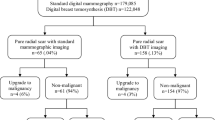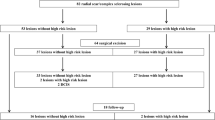Abstract
The prevalence of radial scar (RS) is 0.04% in asymptomatic women participating in population screening for breast cancer. It is important to differentiate RS from concomitant malignancies, which occur in 20–30% of patients, or from small stellate carcinomas which give similar radiomorphology. The aim of our study was to evaluate the effectivity of current breast diagnostic methods in distinguishing between real RS, concomitant malignancy and carcinomas imitating RS. Diagnosis of RS was set up in 61 cases by mammography. Forty-four patients underwent surgical excision: histology showed benign or malignant lesions in 28 and 16 cases, respectively. A series of negative results at follow-up proved the benign nature of the lesion in further 11 cases. Six patients were not available for follow-up. Results of mammography, physical examination, ultrasonography and cytology were evaluated and were compared in 39 benign and 16 malignant cases. Results of examinations were reported on the BI-RADS scale ranging from 1 to 5. The mean categorical scores of all diagnostic processes were around the level of borderline lesions: mammography: 3.49, ultrasonography: 3.06, cytology: 2.47 and physical examination: 1.67. The average age of the patients in the benign and malignant groups were the same: 58years. The two groups did not differ significantly over either distribution of coded mammographical results (p = 0.2092), or the distribution of mammographical parenchyma density patterns (p = 0.4875). However, the malignant and benign groups differed significantly from each other over the distribution of coded ultrasonographic (p = 0.0176) and cytological (p < 0.0001) results. In conclusion, in the preoperative diagnosis of asymptomatic “black-stars”, mammography detects the non-palpable lesions, and ultrasonography together with cytology proved better in the analysis, provided FNAB is US guided. Due to the complex diagnostic approach the nature of the “black stars” is known in the majority of cases prior to the surgical biopsy.





Similar content being viewed by others
References
Wallis MG, Devakumar R, Hosie KB et al (1993) Complex sclerosing lesions (radial scars) of the breast can be palpable. Clin Radiol 48:319–320
King TA, Scharfenberg JC, Smetherman DH et al (2000) A better understanding of the term radial scar. Am J Surg 180:428–432
Mokbel K, Price RK, Mostafa A et al (1999) Radial scar and carcinoma of the breast: microscopic findings in 32 cases. Breast 8:339–342
Tabár L, Dean PB (1983) Teaching atlas of mammography. Thieme, New York
Breast imaging reporting and data system (BI-RADS) (1995) 2nd ed. Reston VA, American College of Radiology
Gram IT, Funkhoser E, Tabár L (1997) The Tabár classification of mammographic parenchymal patterns. Eur J Radiol 24:131–136
Dessole S, Meloni GB, Capobianco G et al (2003) Radial scar of the breast: mammographic enigma in pre-and postmenopausal women. Maturitas 34:227–231
Farshid G, Rush G (2004) Assessment of 142 stellate lesions with imaging features suggestive radial scar discovered during of population-based screening for breast cancer. Am J Surg Pathol 28:1626–1631
Alleva DQ, Smetherman DH, Farr GH Jr et al (1999) Radiographics 19 Spec No S27–35. discussion S36–37
Sloane JP, Mayers MM (1993) Carcinoma and atypical hyperplasia in radial scars and complex sclerosing lesions: importance of lesion size and patient age. Histopathology 3:225–231
Sanders ME, Page DL, Simpson JF et al (2006) Interdependence of radial scar and proliferative disease with respect to invasive breast carcinoma risk in patients with benign breast biopsies. Cancer 106:1453–1461
Kennedy M, Masterson AV, Kerin M et al (2003) Pathology and clinical relevance of radial scars: a review. J Clin Pathol 56:721
Patterson JA, Scott M, Anderson N et al (2004) Radial scar, complex sclerosing lesion risk of breast cancer. Analysis of 175 cases in Northern Irelands. Eur J Surg Oncol 30:1065–1068
Jacobs TW, Byme C, Colditz G et al (1999) Radial scars in benign breast biopsy specimens and the risk of breast cancer. New Engl J Med 340:430
Alvarado-Cabrero I, Tavassoli FA (2000) Neoplastic and malignant lesions involving or arising in a radial scar: a clinico-pathologic analysis of 17 cases. Breast J 6:96–102
Sewel CW (2004) Pathology of high-risk breast lesions and ductal carcinoma in situ. (review) (16 refs) Rad Clin North Am 42:821–830
Denley H, Pinder SE, Tan PH et al (2000) Metaplastic carcinoma of the breast arising within complex sclerosing lesion: a report of five cases. Histopatholog 36:203–209
Lamb J, McGoogan E (1994) Fine needle aspiration cytology of breast in invasive carcinoma of tubular type and in radial scar/complex sclerosing lesions. Cytopathology 5:17–26
Kulka J, Davies JD, Chinyma CN (1996) Benign and malignant stellate breast lesions: structural differences in 5 microns sections and thick tissue slices. Anticancer Res 16:3965–3970
Kopper L, Timár J (2002) Gene expression profiles in the diagnosis and prognosis of cancer. Hung Oncol 46:3–9 (in Hungarian)
Timár J, Jeney A, Kovalszky I et al (1995) Role of proteoglycans in tumor progression. Pathol Oncol Res 1:85–93
Timár J, Csuka O, Orosz Zs et al (2001) Molecular pathology of tumor metastasis. Pathol Oncol Res 3:217–230
Chauhan H, Abraham A, Phillips JR et al (2003) There is more than one kind of myofibroblast: analysis of CD34 expression in benign, in situ, and invasive breast lesions. J Clin Pathol 56:271
Demirkazik FB, Gulsun M, Firat P (2003) Mammographic features of nonpalpable spiculated lesions. Clin Imaging 27:293–297
Ung OA, Lee WB, Greenberg ML et al (2001) Complex sclerosing lesion: the lesion is complex, the management is straightforward. ANZ J Surg 71:35–40
Fasih T, Jain M, Shrimankar J et al (2005) All radial scars/complex sclerosing lesions seen on breast screening mammograms should be excised. Eur J Surg Oncol 31:1125–1128
McBoyle MF, Razek HA, Carter JL et al (1997) Tubular carcinoma of the breast: an institutional review. Am Surg 63:639–644
Livi L, Paiar F, Meldolesi E et al (2005) Tubular carcinoma of the breast: outcome and loco-regional recurrence in 307 patients. Eur J Surg Oncol 31:9–12
Daniele S, Imbriaco M, Riccardi A et al (2003) Mammographic and sonographic features of tubular breast carcinoma 89:417–420
Mitnick JS, Gianutsos R, Pollack AH et al (1999) Tubular carcinoma of the breast: Sensitivity of diagnostic techniques and correlation with histopathology. Am J Roentgenol 172:319–323
Canade A, Constantini M, Magistrelli A et al (2002) Radial scar: from conventional imaging to the new techniques. Case reports. Rays 27:319–323
Pediconi F, Occhiati R, Venditti F et al (2005) Radial scars of the breast: contrast-enhanced magnetic resonance mammography appearance. Breast J 11:23–28
Shetty MK (2002) Radial scars of the breast: sonographic findings. Ultrasound Q 18:203–207
Chan HHL, Lam PTW, Yuen JHF et al (2004) Conditions that mimic primary breast carcinoma on mammography and sonography. J Hong Kong Coll Radiol 7:49–55
Cawson JN (2005) Can sonography be used to help differentiate between radial scars and breast cancers? Breast 14:352–359
Kovacs A, Walker RA (2003) P-Cadherin as a marker in differential diagnosis of breast lesions. J Clin Pathol 56:139
Baum F, Fischer U, Füzesi L et al (2000) The radial scar in contrast media-enhanced MR-mammography. Rofo 172:817–823
Bonzanini M, Gilioli E, Brancato B et al (1997) Cytologic features of 22 radial scars/ complex sclerosing lesions of the breast, three of which associated with carcinoma, clinical, mammographic, and histologic correlation. Diagn Cytopathol 17:353–362
Cawson JN, Malara F, Kavanagh A et al (2003) Fourteen-gauge needle core biopsy of mammographically evident radial scars: is excision necessary? Cancer 97:345–351
Gill HK, Ioffe OB, Berg WA (2003) When is a diagnosis of sclerosing adenosis acceptable at core biopsy? Radiology 228:50–57
Brenner RJ, Jackman RJ, Parker SH et al (2002) Percutaneous core needle biopsy of radial scars of the breast: when is excision necessary? Folyóirat 179:1179–1184
Ruiz-Sauri A, Almenar-Medina S, Callaghan RC et al (1995) A.Radial scar versus tubular carcinoma of the breast. A comparative study with quantitative techniques(morphometry, image-and flow cytometry). Pathol Res Pract 191:547–554
Author information
Authors and Affiliations
Corresponding author
Rights and permissions
About this article
Cite this article
Egyed, Z., Péntek, Z., Járay, B. et al. Radial Scar-Significant Diagnostic Challenge. Pathol. Oncol. Res. 14, 123–129 (2008). https://doi.org/10.1007/s12253-008-9025-0
Received:
Revised:
Accepted:
Published:
Issue Date:
DOI: https://doi.org/10.1007/s12253-008-9025-0




